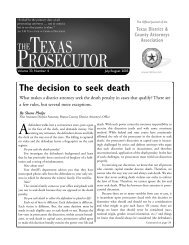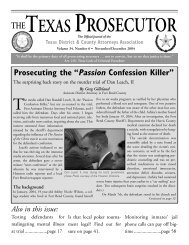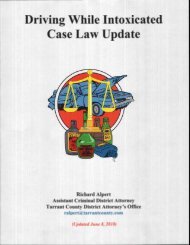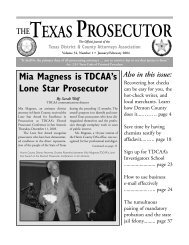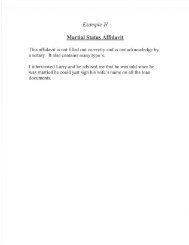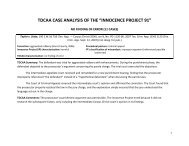Driving While Intoxicated Case Law Update - Texas District ...
Driving While Intoxicated Case Law Update - Texas District ...
Driving While Intoxicated Case Law Update - Texas District ...
Create successful ePaper yourself
Turn your PDF publications into a flip-book with our unique Google optimized e-Paper software.
He stopped and spoke to defendant who stated he had gotten vehicle stuck in ditch. Scene<br />
evidence corroborated vehicle was wrecked and inoperable and officer noted srgns of intoxication<br />
on the defendant. /ssue rar'se d was that even though he was intoxicated when officer made contact<br />
with him, there was no evidence he was intoxicated earlier when accident occurred. ln finding there<br />
was sufficient circumstantial evidence presented that defendant was intoxicated when he was<br />
driving, the Court held that proof of the precise time of accident is not required and that being<br />
intoxicated at the scene of a traffic accident in which the defendant was the driver is some<br />
circumstantialevidence thatthe defendant's intoxication caused the accident, and the inference of<br />
causation is even stronger when the accident is a one-car collision with an inanimate object.<br />
Kuciemba v. State, 310 S.W.3d 460 (Tex.Crim.App. 2010).<br />
Defendant was found behind the steering wheel, injured and intoxicated, at the scene of a one-car<br />
rollover accident, with a blood-alcohol level of more than twice the legal limit. The Court of Appeals<br />
found the evidence to be insufficient to show that appellant was intoxicated at the time that the<br />
accident occurred as there was no evidence of anyone who saw defendant driving on the road or<br />
evidence of when the accident occurred. The Court of Criminal Appeals reversed finding, among<br />
other things, that being intoxicated at the scene of a traffic accident in which the actor was a driver<br />
is some circumstantial evidence thatthe actor's intoxication caused the accident, and the inference<br />
of causation is even stronger when the accident is a one-car collision with an inanimate object.<br />
They focused on the driver's failure to brake, his high BAC, and the fact that he was still bleeding<br />
as supporting an inference that the accident was recent, and he had been intoxicated for quite<br />
awhile.<br />
Stoutner v. State, 36 S.W.3d 716 (Tex.App.-Houston [1't Dist] 2001 , pdr refused).<br />
The defendant tried to argue that McCaffertv was controlling. The Court distinguished fhis case<br />
from McCaffertv asfollows: ln this case, there were fifteen totwenty minutesthat passed from the<br />
time of crash to time officer arrived. Blood sample was taken twenty minutes after the arrest (ftfty<br />
minutes after officer's arrival). Extrapolation evidence was offered. No alcoholic beverage<br />
containers were noticed near defendant. The testimony that defendant did not appear to be<br />
intoxicated to another officer who observed him upon arriving at the scene was not disposifive as<br />
the officer was a car length away from the defendant at the time and was not focused on the<br />
defendant. Sfafe wasnotrequiredtoexclude everyotherreasonable hypothesisexceptdefendant's<br />
guilt as that standard was discarded by Geesa. Evidence found to be sufficient that defendant was<br />
intoxicated while operating a motor vehicle.June 11, 2008.<br />
XXVII. CONDITIONS OF PROBATION . LIMITATIONS<br />
A. STAY OUT OF BARS-CHANGE JOB = OK<br />
Lacv v. State, 875 S.W.2d 3 (Tex.App.-Tyler 1994, no pet.).<br />
Requiring defendant to stay out of bars and taverns or similar places, preventing defendant's<br />
continuing current employment, held to have a reasonable relation to crime and defendant's<br />
criminality.<br />
l_60



